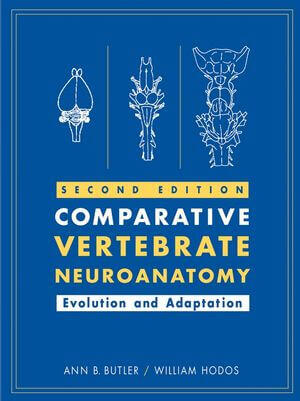Comparative Vertebrate Neuroanatomy: Evolution and Adaptation 2nd Edition
By Ann B. Butler, William Hodos
Comparative Vertebrate Neuroanatomy: Evolution and Adaptation PDF presents a broad survey of comparative vertebrate neuroanatomy at the introductory level, representing a unique contribution to the field of evolutionary neurobiology. It has been extensively revised and updated, with substantially improved figures and diagrams that are used generously throughout the text. Through analysis of the variation in brain structure and function between major groups of vertebrates, readers can gain insight into the evolutionary history of the nervous system. The text is divided into three sections:
- Introduction to evolution and variation, including a survey of cell structure, embryological development, and anatomical organization of the central nervous system; phylogeny and diversity of brain structures; and an overview of various theories of brain evolution
- Systematic, comprehensive survey of comparative neuroanatomy across all major groups of vertebrates
- Overview of vertebrate brain evolution, which integrates the complete text, highlights diversity and common themes, broadens perspective by a comparison with brain structure and evolution of invertebrate brains, and considers recent data and theories of the evolutionary origin of the brain in the earliest vertebrates, including a recently proposed model of the origin of the brain in the earliest vertebrates that has received strong support from newly discovered fossil evidence
Ample material drawn from the latest research has been integrated into the text and highlighted in special feature boxes, including recent views on homology, cranial nerve organization and evolution, the relatively large and elaborate brains of birds in correlation with their complex cognitive abilities, and the current debate on forebrain evolution across reptiles, birds, and mammals.
Comparative Vertebrate Neuroanatomy is geared to upper-level undergraduate and graduate students in neuroanatomy, but anyone interested in the anatomy of the nervous system and how it corresponds to the way that animals function in the world will find this text fascinating.
Related Book: de Lahunta’s Veterinary Neuroanatomy and Clinical Neurology, 5th Edition
This Book is Available For Premium Members Only














![Ettinger’s Textbook of Veterinary Internal Medicine 9th Edition [PDF+Videos] Ettinger’s Textbook of Veterinary Internal Medicine 9th Edition [True PDF+Videos]](https://www.vet-ebooks.com/wp-content/uploads/2024/10/ettingers-textbook-of-veterinary-internal-medicine-9th-edition-100x70.jpg)

![Textbook of Veterinary Diagnostic Radiology 8th Edition [PDF+Videos+Quizzes] Thrall’s Textbook of Veterinary Diagnostic Radiology, 8th edition PDF](https://www.vet-ebooks.com/wp-content/uploads/2019/09/textbook-of-veterinary-diagnostic-radiology-8th-edition-100x70.jpg)






